Olivier de Montmollin
- Associate Professor
Olivier de Montmollin received his PhD from the University of Michigan in 1985. He is an archaeologist interested in the operation of ancient political systems and their impacts on settlement patterns, with a focus on the Maya and other cultures in pre-hispanic Mesoamerica. His other interests include time scales as they are understood by archaeologists and by ancient Mesoamericans, space and ritual communications in ancient cities, changing forms of conflict and consensus linking Mayas to outsiders before and after Spanish conquest, pre-Axial and Axial cosmologies and their impacts on political practices in Mesoamerica (and the Andes), and ethnoarchaeology. He does fieldwork in southern Mexico.
Research Description
Maya Political Organization
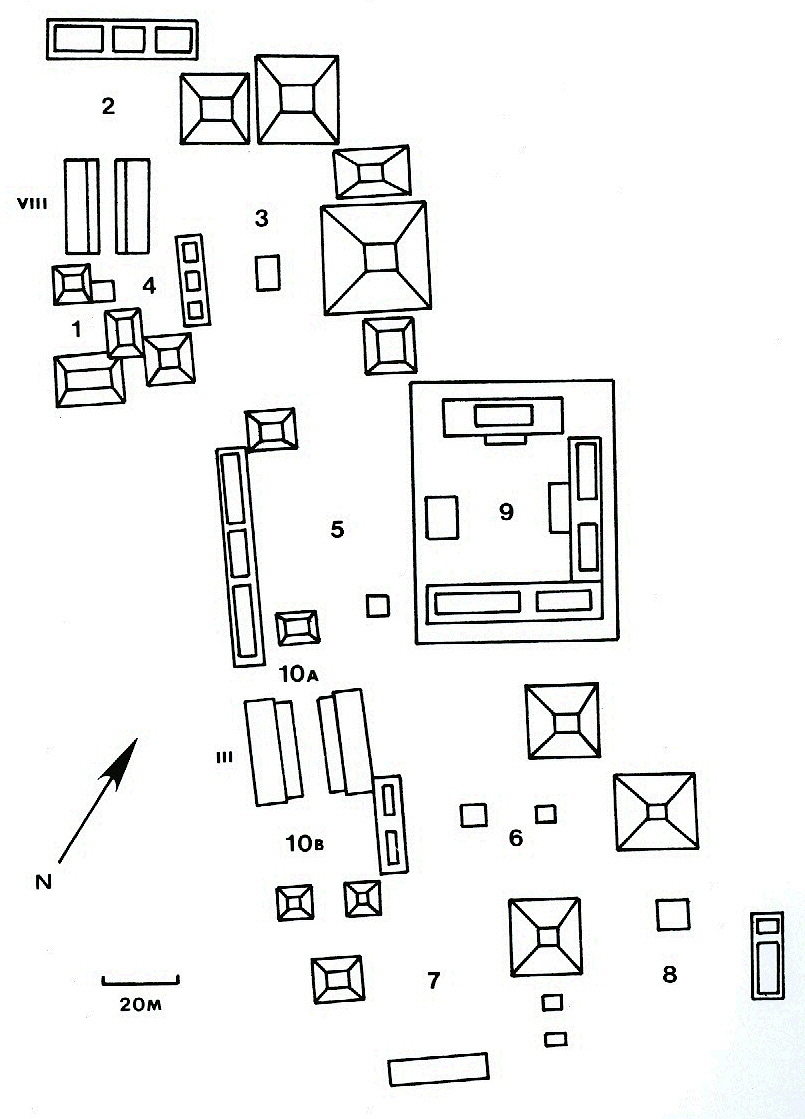
The apparent reproduction of a full three-level political hierarchy within Tenam Rosario is an indicator of centralization, suggesting that the political functions at all levels are centrally carried out at the capital.
Olivier de Montmollin 1989 The Archaeology of Political Structure, Cambridge University Press, p.229
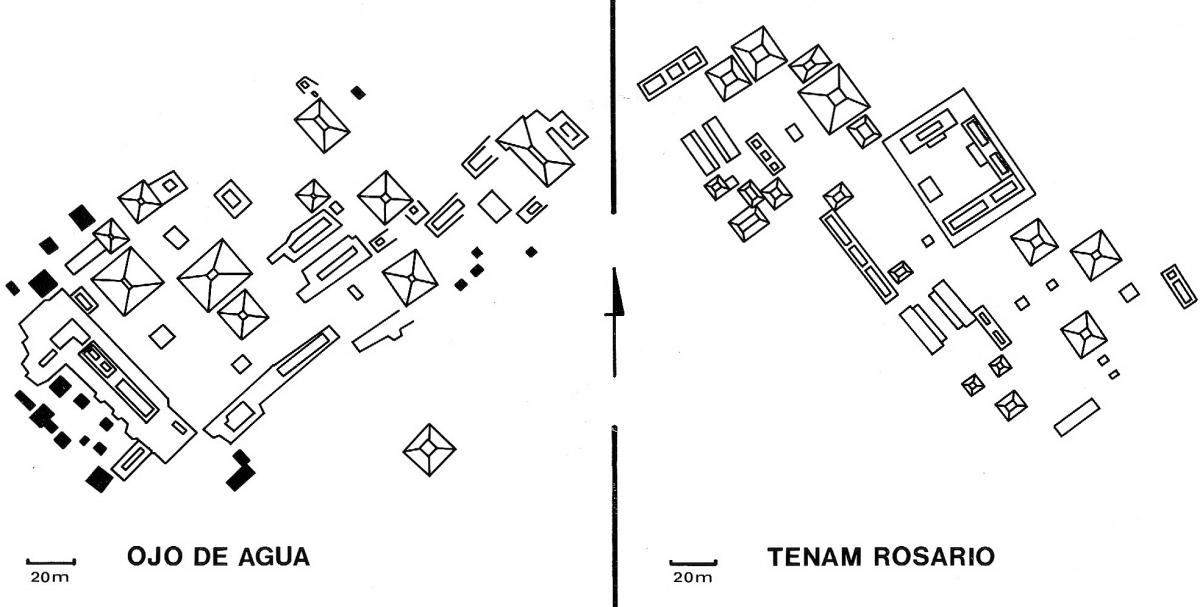
Ojo de Agua lacks Tenam Rosario's symmetrical arrangement of similar-looking plaza complexes flanking a central acropolis-palace...a political microcosm is absent at Ojo de Agua.
Olivier de Montmollin 1995 Settlement and Politics in Three Maya Polities, Prehistory Press, p.121.
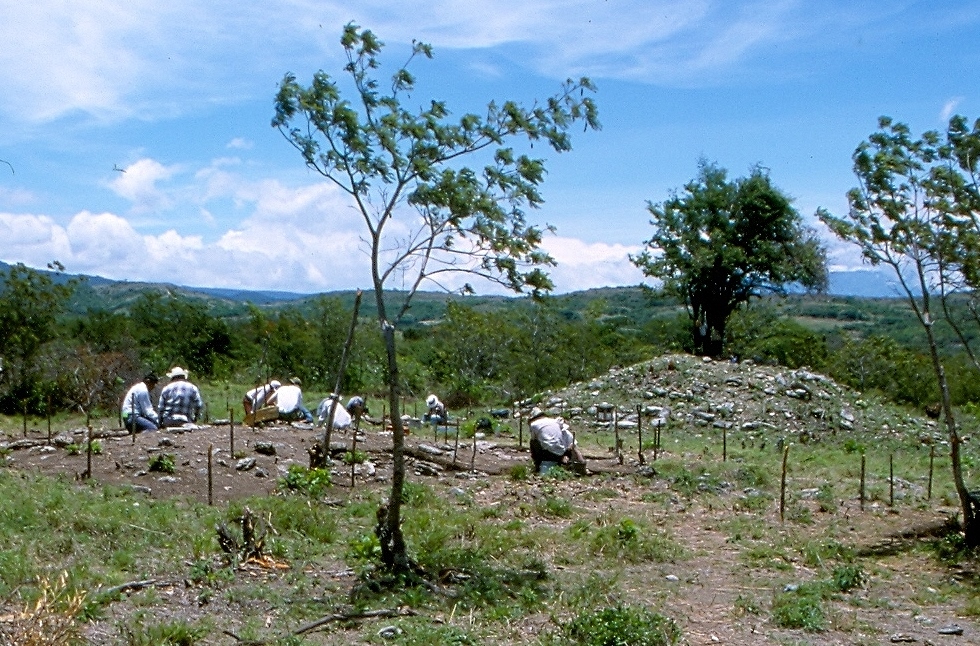
excavation - modest residence at Iglesia Hundida
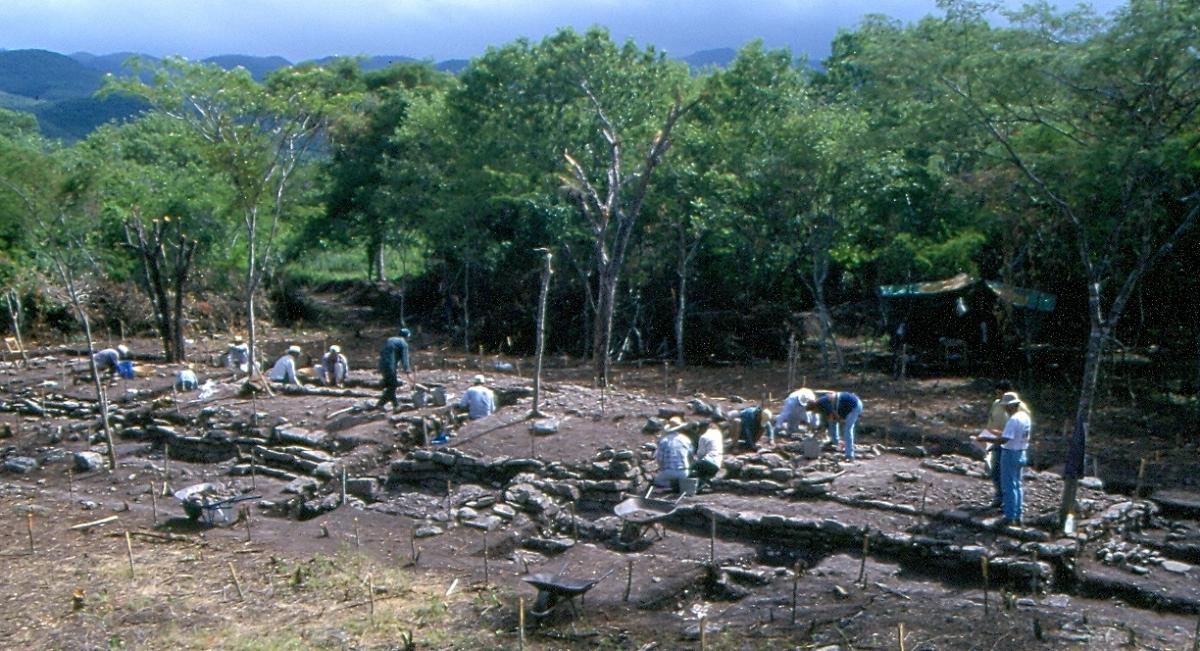
excavation – elite residence, Loma Zorrillo

survey - Cerro La Tuna, residences
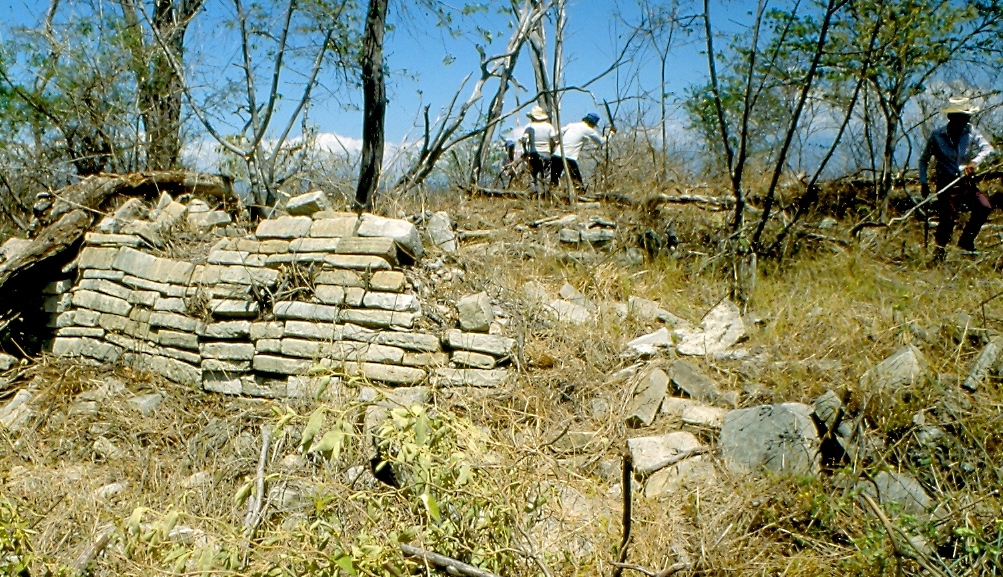
survey – Tenam Concepcion, civic building
Courses
Ancient States in the New World
Graduate/Undergraduate Lecture. This course uses political anthropology concepts and methods to explore diverse political themes relating to ancient prehispanic polities (states and empires) in Mesoamerica and the Andes. Political themes include: intrusion of Old World Spaniards into New World polities; native Mesoamerican and Andean views of their own history and political practices; political actors - apical (royal) rulers and their subjects (nobles and commoners); communications - writing, performance, learning; internal strife - colonial and prehispanic era resistance of subjects against their rulers; external strife - geopolitics (war and diplomacy, Hegemonic and Territorial geopolitical arrangements); political cycling, polities rising and falling; economic underpinnings for politics - political economy, cities, taxes, administration; retrospective accountings - lessons and heritage material gathered by ancient Mesoamericans and Andeans and by current Latin Americans and North Americans as a result of studying ancient New World states and empires.
Evidence used to explore the above themes comes from sets of prehispanic New World states (and sometimes empires) associated with Aztec, Inka, Teotihuacan, Toltec, Zapotec, Mixtec, Maya, Chimu, Tiwanaku-Wari, and Moche civilizations. A principal focus is on the Aztec and Inka empires. These two independently developing empires are the best documented of all ancient prehispanic polities in the New World, as a result of having been conquered and incorporated (and lavishly described) by the agents of an expanding Spanish empire in the 16th century AD.
It makes things even more interesting that the Aztec and Inka empires were highly contrastive, covering between them a wide span of political variations. Information about other states (mostly earlier and more sketchily documented ones) can also be used to further widen the scope of contrastive variations.
Several outcomes result from examining and comparing the themes across the Mesoamerican and Andean cases.
We get a sense of what has and has not changed in political practices and institutions from ancient prehispanic times to modern Latin America. We can start to figure out differences and similarities between 1. ancient states in a non-western and non-axial (New World) statecrafting trajectory and 2. modern nation-states appearing late in a western and axial (Old World) statecrafting trajectory. On a more abstract-conceptual level, we get an understanding of how native New World ideas and practices concerning statecraft converge with or diverge from western political science theories about statecraft (Aristotle, Ibn Khaldun, Machiavelli, Locke, Rousseau and onwards). This highlights a central feature of what makes political anthropology interesting - the use of both insider (native, emic) perspectives and outsider (western, etic) perspectives.
We can draw lessons from the past. We get a basis for judging which (if any) political practices and institutions from the ancient New World can still provide inspiration, guidance, or warnings for present and future political policies and arrangements in Latin America and elsewhere.
Ancient Civilizations
Undergraduate Lecture. This course covers the rise, operation, and fall of several ancient civilizations, the largest and most complex forms of social organization to emerge in pre-industrial times. Lectures span the archaeology and history of several regions recognized as significant arenas for the early and mostly independent development of ancient civilizations: the Mediterranean, Mesopotamia, Egypt, the Indus Basin, China, Southeast Asia, Mesoamerica, and Andean South America. For each region of ancient civilization, several historical stages are reviewed: the rise of earliest civilization from a baseline of ranked societies (chiefdoms), the operation and eventual decline of earliest civilization, and the cyclical rise and fall of successor civilizations.
Ancient civilizations are viewed within a framework of underlying theoretical themes that guide how scholars can organize their thinking about ancient civilizations (and about human societies in general). Theoretical underthemes relate to:
CAUSAL FACTORS AND UNITS OF STUDY
1 Material and Mental Factors
2 Conflict and Co-Operation Factors in Political and Social Life
3 Collectivities (Institutions) and Individuals (Actors)
OBSERVATIONAL PERSPECTIVES
4 Outsider (Etic) and Insider (Emic)
5 Top-Down Elitist and Bottom-Up Populist
6 Retrospective (Hindsight) and “In The Moment”
SOCIO-POLITICAL MECHANISMS/PRINCIPLES
7 Hereditary-Ascribed-Stratified and Achieved-Meritocratic-Egalitarian
WORLD OF ANCIENT IDEAS
8 Non-Axial and Axial Cosmologies-Worldviews
9 Relative Gap between Ontology (Religion) and Epistemology (Technology)
10 Communications Tools - Fluid Speech and Fixed Writing-Iconography.
The approach taken to the multiple cases of ancient civilizations is a comparative one. Our aim in the class is to come to understand noteworthy differences and similarities among ancient civilizations. To bring this into sharpest focus, the last part of the course covers cross-civilization themes of economics, politics, warfare, urbanism, religion and values, literacy, quality of life, and lessons gained from studying the past experiences of people in ancient civilizations.
An outcome of looking at ancient civilizations individually and comparatively is a better understanding of both unfamiliar and familiar aspects of the “past as a foreign country,” which, to the untrained eye seems so distant from our present-day concerns and experiences.
Mesoamerica Before Cortez
Undergraduate Lecture. This course focuses on ancient prehispanic Mesoamerica (in what is now Mexico and Central America). On a global scale, prehispanic Mesoamerica was one of 6-7 areas in the ancient world with locally original development of ancient civilizations. Ancient civilizations within Mesoamerica involved a diachronic development of institutions and practices such as states, cities, armies, irrigation farming, market exchange, writing, strict social inequality, and baroquely elaborate religious beliefs and rituals. Developments of civilizations are tracked and compared across Mesoamerica’s long-lasting social and linguistic sub-divisions: the Central Highlands with Nahuat people, the Southern Highlands with Zapotec and Mixtec peoples, the Gulf Lowlands with Olmec-Zoque people, and the Southern Lowlands with Maya people. In checking these developments, we aim to arrive at:
1. An appreciation of the methodological tools used by archaeologists, historians, art historians, ethnographers, linguists, and biological anthropologists to generate evidence about ancient individuals and events.
2. A crafting of some compelling stories about what happened to ancient families and their communities in various social, political, and economic circumstances.
3. Explanations of how and why ancient people and communities in different times and places within Mesoamerica had similar or different lifestyles and experiences.
4. Understandings of how prehispanic developments in Mesoamerica continue to impact heritage arguments and socio-political practices in parts of the modern Mexico, Central America, and USA.
Archaeology Theory
Undergraduate Seminar (Writing Class). This course covers theories used by anthropological archaeologists when trying to make sense of (prehistoric and historic) archaeological records. Theories from Social Anthropology and other branches of present-focused social sciences are considered with a view to understanding how these theories can be adjusted for meaningful application to people and events from past times. In a nutshell, the ontological and epistemological challenge we face is how best to use analogies from recent times in order to relate unobservable past behaviors to the material residues of those behaviors currently observable by us in archaeological records. The journey through archaeological theory takes us through the following waystations.
GROUNDWORK: Levels Of Theory [High Theory – Middle-Range Theory – Base-Level Theory]; Select Underthemes (High Theory)
HIGH THEORY PROGRAMS: Culture History; Processual New Archaeology, Social Evolution, Ongoing and Cognitive Processual Archaeology; Marxism; Structuralism; After Structuralism; Neo Darwinism
ONTOLOGY/EPISTEMOLOGY: Agency of People and Objects; Time Spans
SUBSTANTIVE ISSUES: Discontinuities (Past is a Foreign Country)
MORE EPISTEMOLOGY: Working with Analogies (Source-Side Issues); Archaeology and History; Archaeology and Art History
ADDITIONAL SUBSTANTIVE ISSUES: Big-Picture Social Evolution [Technology], Disasters and Collapses; Identity, Style, Gender; Early Cognition; Communications; Religion; Politic; Heritage (Nations and Native Minorities); Urbanism.
Ethnoarchaeology
Graduate/Undergraduate Seminar (Writing Class). This course examines ideas and case studies from the anthropological field of ethnoarchaeology. Ethnoarchaeology lies at an intersection between ethnography and archaeology, two of anthropology’s sub-disciplines. Ethnoarchaeologists want to observe living peoples’ practices and to quiz them about their thoughts and behaviors, especially as the thoughts and practices relate to the material record produced by people in the present. Of course, it’s a material record produced by ancient people (dead, inert, mute) which is the primary source of evidence that prehistoric archeologists observe and work with directly.
In other words, an Ethnoarchaeologist sees people acting/thinking and she also sees the material “signatures” of actions and thoughts (houses, artifacts, ecofacts). An Archaeologist does not see people acting/thinking but she does see the material “signatures” of unobserved actions and thoughts. For archaeologists looking backward into past time, ethnoarchaeology studies provide useful information needed to build interpretive models for inferring what were the past peoples’ thoughts and practices that produced the material remains seen and studied today in the archaeological record.
For social anthropologists (and other social scientists such as historians, political scientists, and sociologists) looking across a range of past-present-future timespans, ethnoarchaeological studies are interesting because they contribute fresh and vivid information about the varied ways that relatively more recent (more directly observable) peoples, including our WEIRD (Western, Educated, Industrialized, Rich, and Democratic) selves, are entangled with material worlds.
In the widest theoretical sense, the span of ethnoarchaeological studies and discoveries is becoming cosmological, part of an Ontological Turn in social sciences. It is starting to cover the relations between people and their “material” world, with that world being expanded beyond just inorganic matter to include plants, bugs, worms, animals, and what are/were often perceived to be divine forces. Thinking about ethnoarchaeology in these ways also allows us as mere archaeologists to access and explore a path-breaking re-think in Social Anthropology and other social sciences about how humans have connected and continue to connect themselves to worlds of animals, plants, and things (a re-think known as the Ontological Turn).
Traveling through an ethnoarchaeology theme park, we visit the following attractions: Thinking Ethnoarchaeology; Site Formation, Fieldwork; Subsisting - Hunter/Gathering; Subsisting – Farming; (Categorizing and) Crafting Pots and Lithics; Identifying Ourselves Stylishly; Interacting, Feasting, Big-Manning, Factioning; House Containers Enveloping Communities, Families; Families Experiencing Homes and Gardens; Managing the Dead; Thinking with Things, Religion; Relating to Things, Divinities, and Other Non-Human Species.
Archaeological Method and Theory
Graduate Seminar (Writing Class). This course covers methods and theories in anthropological archaeology.
TOPIC 0 - Setting Up A Framework
*Levels of Theory: Material is organized according to a framework of levels of theory - high (substantive) theory [HT], middle-range or bridging theory [MRT], and basal or observational theory [BLT]. In a colloquial sense, HT corresponds to theory proper and MRT and BLT correspond to methods.
*Recurrent Underthemes: Different HT programs’ claims and research practices are understood by using a working checklists of persistently recurring underthemes. One such checklist is the following:
HOW WE DESIGN OUR STUDIES (PROCEDURE ISSUES)
Units Of Study
1 social systems and individual actors
Epistemological Perspectives
2 outsider (etic) and insider (emic)
3 retrospective and “in the moment” time placements
4 realist and anti-realist
5 correspondence and coherence truth criteria
HOW WE CONCEPTUALIZE THE TARGET OF OUR STUDY (SUBSTANCE ISSUES)
Causal Factors
6 material and mental/ideological
7 coercion and consensus in socio-politics
Socio-Political Mechanisms and Logics
8 top-down (elitist) and bottom-up (populist) mechanisms
9 constructivist and essentialist logics for identities
World Of Ideas and Information
10 modern (axial) cosmologies and ancient (non-axial) cosmologies
11 matches between cosmo-ontology and epistemology
12 information technology - fluid speech, fixed writing
*Historical Discontinuities: Thoughtful archaeologist looking back at the past can check their presentism by considering historical discontinuities or they can indulge their presentism by ignoring or minimizing such discontinuities. A partial (complex society-oriented) listing of such discontinuities covers:
1. ECONOMICS - Non-Market or Market
2. ENERGY CAPTURE – Feeble to Massive
3. presence/absence of Concept of CIVILIZATION vs. NOT-CIVILIZATION
4. STATECRAFT – Archaic to Early Modern to Modern Regimes
5. presence/absence of ETHNIC-BASED CONFLICT and NATIONALISM
6. NON-AXIAL vs. AXIAL COSMOLOGY
7. presence/absence of “RELIGION”
8. GROUP vs. INDIVIDUALIZED PERSONHOOD
9. COMPLEMENTARY vs. PATRIARCHAL GENDER
10. presence/absence of FEMINIST Concepts
11. presence/absence of LITERACY
12. presence/absence of Printing Press
13. presence/absence of AESTHETICS and ART
TOPICS 1-4 - Bazaar of HT Programs
We get an overview of several kinds of HT programs used by archaeologists. The varieties of HT are found as one (metaphorically) cruises up and down the more programmatic aisles of a theory bazaar. The HT perspectives are arranged in a series of aisles linked to three variants of past-focused thinking that emphasize different kinds of records – archaeology (things), history (glottographic and semasiographic communications), and art history (images); a fourth multi-aisle contains a potpourri of thematically shiny new stuff.
TOPIC 1 Archaeology Aisle: Old Archaeology (Culture History); New Archaeology (Socio-Cultural Evolution [SCE]); Ongoing SCE; Social (Structural-Functional) Archaeology; Ideology-Focused SCE; Archaeology Of Mind; Behavioralism; Neo-Darwinian Selectionism
TOPIC 2 History Aisle: Marxism; “Annales” (Social History); Americanist Ethnohistory; Critical Historical Archaeology; Historiography
TOPIC 3 Art History Aisle: Earlier and Ongoing Post-Processualism;
Structuralisme; Thinking And Communicating with Things; Image and Word
TOPIC 4 More Aisles Worth Strolling Down: Next Thing - Matter-Mind; Next Thing – Comparisons/Networks, Complexity; Advanced Agency – Cartesians to Experientials (Phenomenology); Historical Discontinuities/Continuities; Externals-Internals, Philosophy Of Science
TOPIC 5 - Material Correlates Of Ancient People’s Experiences-Thoughts-Practices-Behaviors: deals with middle range theory = efforts to bridge between material patterns observed in the archaeological record and what really interests anthropological archaeologists - the behaviors, experiences, thoughts, and practices of past peoples and their societies, seen in the contexts of conditions and events occurring in the past. Middle range tools worth thinking about and understanding include: ethnographic, historical, and other kinds of analogy, replicative experiments, and ethnoarchaeology. Understanding the formal logic and the informal manipulation of analogies is a key to working around Middle Range Theory in anthropological archaeology.
TOPIC 6 - Research Designs For Problem-Oriented Anthropological Archaeology: explores why and how different levels of theories and observational methods are conventionally woven together in the research designs crafted by anthropological archaeologists.
TOPICS 7-9 Dimensions Of Archaeology – Form, Time, Space
Two Topics address how archaeologists deal with the form[al] dimension of their discipline. TOPIC 7 covers form-related issues relating to material styles which in turn are linked to substantive identity/ethnicity issues. TOPIC 8 covers additional form-related issues associated with classifications of artifacts. We can also explore some classificatory-typological reasoning used in other realms such as settlements (space-substance), social organization (substance), and roving bands of rival archaeologists. Finally, form-related issues are linked to substantive technology issues.
TOPIC 9 concerns a variety of ways that archaeologists can think about and “measure” an archaeological record’s time dimensions. There are also some extensions into the substantive arena of other peoples’ times.
TOPICS 10-13 - Thinking About and Investigating Substantive Research Themes Relevant To Past Societies
The last topics cover examples of how diverse archaeological theories and methods are used to develop currently interesting substantive research themes and findings relating to a variety of past societies. The research themes are ordered in a way that reflects their varying relevance to societies arrayed for analytical convenience on a continuum from earlier smaller-simpler cases to later larger-more complex cases – bands, tribes, chiefdoms, states, empires (BTCSE).
TOPIC 10 covers earlyish Band/Tribe-flavored themes: Early Thought; Early Inequality; Roots Of Farming.
TOPIC 11 covers Tribe/Chiefdom/State-flavored themes: Religion; Burials.
TOPIC 12 covers State/Empire-flavored themes: Ancient and Modern Political Economics; Literacy; City Living.
TOPIC 13 covers State/Empire-flavored themes: Politics; Nationalism, Heritage, Resistance.
Maya Resistance
Graduate/Undergraduate Lecture. In this class we aim to understand the motivations, practices, and experiences of Maya peoples (ancient through modern – spanning AD 1-now) as they have mounted political, cultural, and economic resistance and accommodation with reference to non-Maya outsiders. If you are interested in the workings of xenophobia-nativism versus xenophilia-cosmopolitanism, the Maya cases of dealing with outsiders can be powerfully informative and evocative, especially when viewed across the diversity of circumstances and possibilities that characterizes the following timespans: Prehispanic times (AD 1-1520), Spanish conquest/colonial times (AD 1520-1820), Mestizo independence times (AD 1820-1940), and Mestizo modernizing times (AD 1940-now).
To make better sense of the issues we start by moving diachronically through Maya-outsider interactions for the last 500 years, book-ended by an epic (spice and gold and soul-seeking) Spanish conquest of Mayaland and an equally epic expansion of globalizing (income-seeking) Maya workers into foreign places and economies. With a handle on the better documented and theorized last 500 years (the “modern” era in European history terms), we go on to cover the previous and much more thinly documented and theorized prehispanic cases of Maya-outsider interactions (AD 1-1520). A key aim here (especially for those who are “aficionados” of studying the past using “historical imagination”) is to puzzle out the relevance of understandings (and analogies) based on more thickly understood modern times (AD 1520-2015) to arguably very different pre-modern times (AD 1-1520).
With reference to the different time periods, a variety of anthropological research methods are useful. For the Maya in colonial/independence times ethnohistory predominates. For the most recent Maya the emphasis is on ethnography. For the prehispanic Maya the focus is on archaeology and epigraphy.
To make sense of the diverse cases of conflict (xenophobia) and accommodation (xenophilia), we can draw on multiple lines of anthropological thinking, many of them originally developed with reference to studies of Maya people, communities, and polities. Such lines of thinking concern: violent peasant rebellions, everyday peasant resistance, ethnic nationalism, cultural essentialism, invented traditions, testimonial history, mythohistory, cultural renaissance or revitalization movements, gender and native authenticity, religious conversion (orthodoxy and syncretism), axial versus non-axial thinking (with more or less exoticizing for divine non-human forces), ethnic and communal tradition as imposed trap or chosen defense mechanism, uses of material culture for communication, and literacy as trap or defense.
Topics and cases include the following.
INTRODUCTION: Maya resisters; up and down the river of time (AD 1-2015); ideas about native resistance in anthropological and world historical contexts.
CONQUEST/COLONIAL TROUBLES (AD 1520-1820): Spanish conquests; Cancuc revolt; Canek disturbance and others; colonial overview, independent frontiers.
INDEPENDENCE TROUBLES (AD 1820-1940): Independence overview;
Yucatan Caste War and aftermath; Chamula Caste War.
RECENT TROUBLES (AD 1940-now): Chiapas - indigenist Mexican state, conflict performed, Zapatistas; War in Guatemala – overview, communities, testimonies, Maya cultural renaissance seen by us (etics) and them (emics), post-war Guatemala, globalized livelihood, new religions; modern comparisons.
LOOKING BACK TO PREHISPANIC TROUBLES (AD 1-1520): prehispanic overview; Classic Maya kingdoms and Teotihuacan; Epi/Postclassic Toltec “conquest” of Yucatan; Postclassic Highland bi-ethnic “conquest” states; everyday prehispanic Maya peasant resistance.
New World Native Resistance
Graduate/Undergraduate Lecture. The class covers native societies in the New World, with special attention to how people in these societies worked out their conceptual, political, and economic resistance to outsiders who were seeking to dominate them in conquest, colonization, and post-colonization settings. The analytical focus is primarily on native insurgents but also extends to non-native (Spanish, Mestizo, and African) practitioners of domination and counter-insurgency directed at natives. The entry point is to focus on native strategies of resistance, but other strategies available to natives for interacting with outsiders come into view as well, including collaboration, complicity, emulation, self-assimilation, and exodus into a diaspora. The native societies we look at exist(ed) in an environment of states and empires. Taking a long view of the subject, we consider cases of overt and covert conflict and resistance ranging from prehispanic times right through to current times, with the cases of resistance sprinkled across a span of 2,000 years. The first part of the class covers colonial through early independence and modern times (1520-now). After getting to know that 500 year span of variably dysfunctional relations between New World natives and exotic Old World outsiders, we turn back to pre-colonial times (1-1520) to explore in what ways conceptual/cosmological, political, and economic conflicts might have played out in the earlier pre-colonial states and empires and to consider how native vs. outsider alignments were relevant to such conflicts.
Many of the cases examined concern Maya peoples and societies in what is now southern Mexico and upper Central America. Since the Spanish conquest, Maya societies have been impressively troublesome (squeaky wheels) to their Spanish, Criollo, and Mestizo rulers. Consequently there is almost unequaled breadth and detail in outsider-generated “rap sheets” for the Maya. Additionally, Maya leaders and scribes generated their own elaborate (and sometimes sarcastic) records of their rancorous conflicts with outsiders. For comparison, balance, and variety, additional cases of resistant native societies are drawn from other parts of New Spain/Mexico and from Andean parts of South America.
Appreciating what the records can tell about the experiences and thoughts of the people who participated in the stirring and tragic disputes between natives and outsiders is engaging work for scholars using outsider and retrospective perspectives. It forces them to get over themselves by shedding solipsism, ethnocentrism, and presentism, while developing “historical imagination”. Following a recipe from Marshall Sahlins (anthropologist, comedian, pamphleteer), in order to appreciate past peoples and their interesting troubles, we can bring counter-pieties, lashings of dark humor, lateral thinking, and keen curiosity about what actors before us were interested in [Sahlins 2008 The Western Illusion of Human Nature, Prickly Paradigm Press].
New World Resistance topics and cases include.
THINKING ABOUT NATIVE RESISTANCE [Then and Now]: Latin America, native resisters, timerivers; starter toolkits for thinking about native resistance
CONTACT/COLONIAL TIMES [1520-1820]: Spanish Conquests for Mesoamerica and Andes [1520-1570]; Colonial overview; Cancuc Maya [1712] and Canek Maya [1761] revolts; independent natives on New Spain frontiers - Peten Itza Maya [1697] and Pueblos [1680-1696]; Andes Colonial revolts [1500s-1600s]; Tupac Amaru rebellion [1780-1781]
INDEPENDENCE TIMES [1820-1920]: Independence overview; Yucatan Maya Caste War [1840-1910]; Chamula Maya Caste War [1868-1870]; later Mapuche Wars in Chile [1820-1883]
MODERN TIMES [1920-2020]: Modern overview/issues; Revolutionary Indigenist Mexican State and Mayas [1910-1980]; conflict performed [timelessly] and Maya Zapatistas [1994-now]; Guatemala War [1980s]; Testimonies and Maya Cultural Renaissance [1990s-now]; Andean Nativism/Indigenism [20th c.]; Peru - Sendero Luminoso [1980-now]; Mesoamerica and Andes - Globalization, Diaspora, Evangelization [1980s-now]
PREHISPANIC TIMES [1-1520] - Prehispanic overview; Mesoamerica - Classic Maya kingdoms and Teotihuacan [200-500]; Postclassic Mayas and Toltecs [900-1520]; Andes - Middle Horizon diasporas and “globalizations” [600-1000]; “Ethnic” polities before/during Inka Empire [1200-1450, 1450-1540]; peasant resistance vs. exoticizing rulers [timeless]
UPSTREAM and DOWN: backwards/forwards with native resistance [2000 BP – now]
Publications
de Montmollin, O. (2012) Comparing ritual life in different households from a Classic (AD 600-900) Maya community. In Arqueología Reciente de Chiapas: Contribuciones del Encuentro Celebrado en el 60e Aniversario de la Fundación Arqueológica Nuevo Mundo, edited by L.S. Lowe and M.E. Pye, pp. 87-100. Provo, Utah: Papers of the New World Archaeological Foundation 72.
de Montmollin, O. (1997) “A regional study of Classic Maya ballcourts from the Uppermost Grijalva Basin, Chiapas, Mexico,” Ancient Mesoamerica, 8: 23-41.
de Montmollin, O. (1995) Settlement and Politics in Three Late Classic Maya Polities. Madison, Wisconsin: Prehistory Press.
de Montmollin, O. (1989) The Archaeology of Political Structure. Settlement Analysis in a Classic Maya Polity. Cambridge: Cambridge University Press.
de Montmollin, O. (1989) Settlement Survey in the Rosario Valley, Chiapas, Mexico. Provo, Utah: New World Archaeological Foundation Papers 57.
de Montmollin, O. (1989) “Land tenure and politics in the Late/Terminal Classic Rosario Valley, Chiapas, Mexico,” Journal of Anthropological Research, 45: 293-314.
de Montmollin, O. (1988) “Tenam Rosario - A political microcosm,” American Antiquity, 53: 351-370.
de Montmollin, O. (1988) “Scales of settlement study for complex societies: analytical issues from the Classic Maya area,” Journal of Field Archaeology, 15: 151-168.
de Montmollin, O. (1988) “Settlement scale and theory in Maya archaeology,” In Recent Studies in Pre-Columbian Archaeology, edited by N.J. Saunders and O. de Montmollin, pp. 63-104. Oxford: British Archaeological Reports International Series 421(i).
de Montmollin, O. (1987) “Forced settlement and political centralization in a Classic Maya polity,” Journal of Anthropological Archaeology, 6: 220-262.